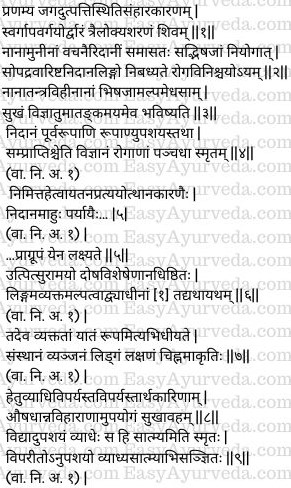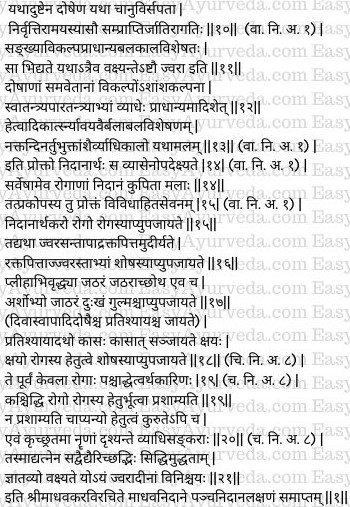Madhava Nidana Chapter 1 Pancha Nidana Lakshana
Table of Contents
Introduction
Madhava Nidana forms a part of ‘Laghu Trayi’ or lesser triad of Ayurvedic treatises, the other 2 being Sharangadhara Samhita and Bhavaprakasha. Madhava Nidana is a compilation of verses and references related to Nidana Panchaka of a disease (with exception of Upashaya and Anupashaya). Madhava Nidana excludes the treatment aspect and gives us a compilation of Nidanas for easy understanding of diseases. Here in this article we are learning about Madava nidaana 1st chapter “Pancha Nidaana Lakshana”.
Read – Acharya Madhavakara: His Work ‘Madhava Nidana’, Legacy, Amazing Facts

Origin of ‘Roga Viniscaya’
I have composed this ‘Roga Viniscaya’ treatise after offering my salutations and worship (prayers) to the holy feet of Lord Siva who is the chief cause for the creation, maintenance and destruction of the entire universe, one who bestows heaven and salvation and the protector of all the three worlds. I have composed this treatise based on the advice and motivation given to me by the revered physicians. The treatise also comprises the sayings of various sages on the complications, prognosis, causes, signs and symptoms of the diseases in brief.
This will help the physicians having low intellect, not having precise knowledge of various shastras – treatises (and hence unable to study and understand them). This treatise named ‘roga viniscaya’ has been composed with an idea of helping such physicians to gain the knowledge of various diseases and also to understand them. (1-3)
Note – Here the author of this treatise claims and announces the objectives with which he has composed this treatise and the purpose and kinds of physicians it would serve.
Read – Nidana: Meaning, Word Derivation, Definition
Nidana Panchaka – Five means of understanding the diseases
The five means or tools of understanding the diseases are –
1. Nidana – causes, aetiology, aetiological factors of the disease,
2. Poorvaroopa – premonitory symptoms, prodromata of the disease
3. Roopa – signs and symptoms; clinical features, symptomatology of the disease,
4. Upasaya – diagnostic tests, pacification and aggravating factors which can be used for diagnosing the diseases through trial and error methods and also to differentiate one disease and the other through differential diagnosis and also to determine the prognosis of the diseases and
5. Sampraapti – pathogenesis of a disease, the process and pathway of formation of the disease (story of development of a disease, step by step)
These five means of understanding the diseases are called as Nidana Panchaka. (4)
Synonyms of Nidana
The synonyms of Nidaana (causative factors or etiological factors of the disease) are –
Nimitta
Hetu
Ayatana
Pratyaya
Utthaana and
Kaaraṇa (5)
Read – Relationship Of Doshas With Nidana Panchakas
Purvarupa
Purvarupa – Premonitory symptoms of the disease
Poorvaroopa means ‘premonitory symptoms’ of the diseases. These are those signs and symptoms which appear earlier to the actual disease i.e., the purvarupas appear before the manifestation of the actual disease. These purvarupas are not specifically assignable to the doshas as they are mild in nature (not clearly recognizable) and few in numbers. (6)
Roopa
Rupa – signs and symptoms of the disease
The same premonitory signs and symptoms manifesting clearly in the later time are known as rupa i.e. ‘signs and symptoms proper’ or specific features of the disease. They synonyms of rupa are – vyanjana, linga, laksana, cinha and akriti. (7)
Read – Roopa – Symptoms: Definition, Types, Benefits of its knowledge
Upashaya
Upashaya – factors (medicine, food, activity) subsiding the disease and thereby helping in diagnosing (or differentially diagnosing) a disease
Upashaya is the administration of medicine, food or activity which bring about sukha (comfort, relief of symptoms) to the patient; (thereby helping in diagnosis).They are of the following kinds viz:
1. Vipareeta (opposite) of hetu (cause), vyaadhi (disease) or both,
2. Vipareetha arthakaari (producing the opposite effect though not actually opposite) to either the hetu (cause), vyaadhi (disease) of both.
This (upasaya) is also known as saatmya (compatible). The opposite of upashaya is anupasaya (increasing the discomfort) or asaatmya (incompatible) to the disease. (8-9)
Read – Upashaya Anupashaya – Pacifying And Non-Pacifying Factors Of Disease
Samprapti
Samprapti – pathogenesis of the disease
The process of manifestation of the disease, by the morbid doshas which are circulating all over the body is known as sampraapti. Jaati or aagati are the synonyms of samprapti. (10)
Sanskrit Versus


Types of Samprapti
Sankhyaa, Vikalpa, Praadhaanya, Bala and Kaala are the five types of samprapti.
| Sl No | Name of the Samprapti | Example |
| 1 | Sankhyaa Sampraapti; | Counting jwaras (fevers) as eight in number etc (types and subtypes of diseases) |
| 2 | Vikalpa Sampraapti | To point out a symptom or a disease as arising from a specific property of a particular dosha (fractional understanding) |
| 3 | Praadhaanya Sampraapti, | To signify a disease as primary (or secondary) |
| 4 | Bala Sampraapti | To qualify a disease as severe or mild depending upon the cause etc. (to determine the strength and severity of a disease) |
| 5 | Kaala Sampraapti | To signify that a disease is severe during a particular period of time such as night, day, season, time of digestion of food, etc. |
These will be elaborated later. (11-13)
The morbid (increased) doshas are considered to be the cause for all kinds of diseases. On the other hand, indulgence in different kinds of unhealthy foods or activities is considered to be the cause for morbid (abnormal) increase of the doshas. (14)
Read – Samprapti Ghatakas – Components Of Manifestation Of Disease
Nidanarthakara Roga – Sometimes one disease might become a cause for another disease. Examples include-
- Increased temperature of jwara (fever) may result in Raktapitta (bleeding disorders, purpura)
- Raktapitta may cause manifestation of fever
- Both jvara and raktapitta together may cause sosa (consumption, tuberculosis)
- Pliha vrddhi (enlargement of spleen) may cause jathara roga (enlargement of abdomen)
- Jathara (abdominal enlargement) may cause Sotha (oedema)
- Arsas (piles) may become the cause for troublesome jathara dukha (abdominal pain) and also gulma (abdominal tumor)
- Divasvapna etc. doshas i.e., Sleeping at day time etc. (causative factors) might result into Pratisyaya (common cold)
- Pratisyaya may lead to kasa i.e., cough
- Kasa would lead to ksaya (emaciation) and
- Ksaya might cause sosa roga (tuberculosis, consumption)
At the beginning the causative disease is just a mild symptom complex. In due course of time, it might become a major disease. Some of them may disappear when the second disease manifests. On the other hand, some others continue to persist even as the second disease exists (during the course of the second disease). This would lead to a condition called vyadhi sankara i.e., coexistence of two or more diseases (like a syndrome) which is very troublesome. (15-20)
So, the physician who desires to become successful should strive hard to understand the diagnosis of diseases like jwara etc. which will be described further on. (21)
Thus ends the chapter called ‘Panchanidana Lakshana’ in the book Madhava Nidana, written by Acharya Madhavakara.










